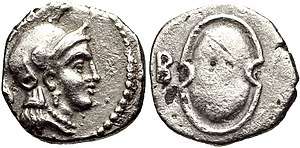Somatophylakes
Somatophylakes (Greek: Σωματοφύλακες; singular: somatophylax, σωματοφύλαξ,) in its literal English translation from Greek, means "bodyguards."
The most famous body of somatophylakes were those of Philip II of Macedon and Alexander the Great. They consisted of seven men, drawn from the Macedonian nobility, who also acted as high-ranking military officers, holding command positions such as general or chiliarch. Alexander the Great appointed Peucestas as eighth somatophylax after the siege of Malli.
Somatophylakes of Alexander the Great
- 336–334
- 333,
- Aristonous, Lysimachus, Peithon, Arybbas, Balacrus, Demetrius, Hephaestion.
- 332
- Aristonous, Lysimachus, Peithon, Arybbas, Menes of Pella, Demetrius, Hephaestion.
- 331
- Aristonous, Lysimachus, Peithon, Leonnatus, Menes, Demetrius, Hephaestion.
- 330–327
- Aristonous, Lysimachus, Peithon, Leonnatus, Perdiccas, Ptolemy of Lagus, Hephaestion.
- 326–324
- Aristonous, Lysimachus, Peithon, Leonnatus, Perdiccas, Ptolemy of Lagus, Hephaestion, Peucestas
- 323
- Aristonous, Lysimachus, Peithon, Leonnatus, Perdiccas, Ptolemy of Lagus, Peucestas.
gollark: ABR *does not see* the channel and it troubles me.
gollark: ++magic py bot.get_channel(781358489418989568)
gollark: ++magic py bot.get_channel(826924583466172453)
gollark: Okay, granting it all perms on that failed...
gollark: ++magic py type(bot.get_guild(733813103891972130).get_channel(826924583466172453))
See also
References
- Rider, Georges Le (2007). Alexander the Great: Coinage, Finances, and Policy. American Philosophical Society. p. 153. ISBN 9780871692610.
External links
This article is issued from Wikipedia. The text is licensed under Creative Commons - Attribution - Sharealike. Additional terms may apply for the media files.
